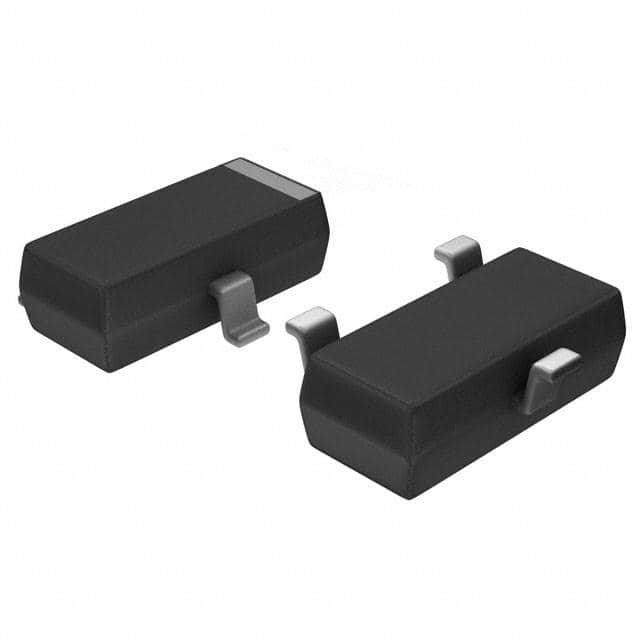MMBT3904 Transistor
Introduction
The MMBT3904 is a general-purpose NPN bipolar junction transistor (BJT) commonly used in electronic circuits for amplification and switching purposes. This entry provides an overview of the MMBT3904, including its basic information, specifications, pin configuration, functional features, advantages and disadvantages, working principles, application field plans, and alternative models.
Basic Information Overview
- Category: Electronic Component
- Use: Amplification and Switching
- Characteristics: High voltage and current capability, low noise, and high frequency operation
- Package: SOT-23
- Essence: Small signal transistor
- Packaging/Quantity: Typically available in reels of 3000 units
Specifications
- Collector-Base Voltage (VCBO): 60V
- Collector-Emitter Voltage (VCEO): 40V
- Emitter-Base Voltage (VEBO): 6V
- Collector Current (IC): 200mA
- Power Dissipation (Pd): 350mW
- Transition Frequency (ft): 250MHz
- HFE (Gain): 100-300
Detailed Pin Configuration
The MMBT3904 transistor has three pins: 1. Emitter (E): Connected to the N-type material 2. Base (B): Controls the transistor's conductivity 3. Collector (C): Collects electrons from the base region
Functional Features
- High voltage and current handling capabilities
- Low noise characteristics
- Suitable for high-frequency applications
- Compact SOT-23 package for space-constrained designs
Advantages and Disadvantages
Advantages
- Versatile and widely used in various electronic circuits
- High gain and low saturation voltage
- Compact package suitable for miniaturized designs
Disadvantages
- Limited power dissipation capability
- Susceptible to thermal runaway at high currents
Working Principles
The MMBT3904 operates as a current-controlled switch or amplifier. When a small current flows into the base terminal, it controls a much larger current flowing between the collector and emitter terminals, allowing the transistor to amplify signals or act as a switch in electronic circuits.
Detailed Application Field Plans
The MMBT3904 is commonly used in the following applications: - Audio amplifiers - Signal amplification circuits - Switching circuits - Oscillators - RF amplifiers
Detailed and Complete Alternative Models
Some alternative models to the MMBT3904 include: - 2N3904 - BC547 - 2SC945 - PN2222A
In conclusion, the MMBT3904 transistor is a versatile component with wide-ranging applications in electronic circuits due to its high voltage and current capabilities, low noise characteristics, and compact package. While it has limitations in power dissipation and thermal management, its performance and versatility make it a popular choice for various electronic designs.
[Word Count: 410]
Senaraikan 10 soalan dan jawapan biasa yang berkaitan dengan aplikasi MMBT3904 dalam penyelesaian teknikal
What is the MMBT3904 transistor used for?
- The MMBT3904 is a general-purpose NPN bipolar junction transistor commonly used for amplification and switching applications in electronic circuits.
What are the typical operating conditions for the MMBT3904?
- The MMBT3904 operates at a maximum collector current of 200mA, with a maximum collector-emitter voltage of 40V.
How do I determine the pinout of the MMBT3904 transistor?
- The pinout of the MMBT3904 is typically Emitter-Base-Collector (EBC) when viewing the flat side of the transistor with the pins down.
What are some common circuit configurations using the MMBT3904?
- Common configurations include common emitter amplifiers, switch circuits, and digital logic gates.
What are the key characteristics of the MMBT3904 that make it suitable for low-power applications?
- The MMBT3904 has low saturation voltage and high current gain, making it suitable for low-power applications.
Can the MMBT3904 be used in high-frequency applications?
- Yes, the MMBT3904 can be used in high-frequency applications due to its fast switching speed and low capacitance.
What are the thermal considerations when using the MMBT3904 in a circuit?
- It is important to consider heat dissipation and ensure that the operating temperature of the transistor remains within its specified range to prevent damage.
Are there any common failure modes associated with the MMBT3904?
- Common failure modes include thermal runaway due to excessive current or voltage stress, as well as breakdown under high power dissipation.
What are some alternative transistors that can be used as substitutes for the MMBT3904?
- Alternatives include 2N2222, BC547, and BC548, which have similar characteristics and pinouts.
Where can I find detailed application notes and reference designs for using the MMBT3904 in technical solutions?
- Detailed application notes and reference designs can be found in the datasheets provided by semiconductor manufacturers or through online resources such as application-specific forums and websites.


